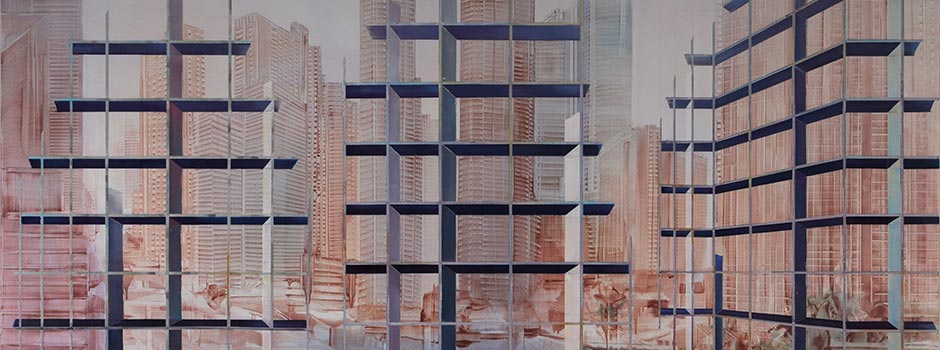
EXHIBITION AT LAWRIE SHABIBI (Nov 2 - Nov 27, 2014) ‘Inside Zenith’, a Solo Exhibition by Driss Ouadahi
Oct 14, 2014 Exhibition

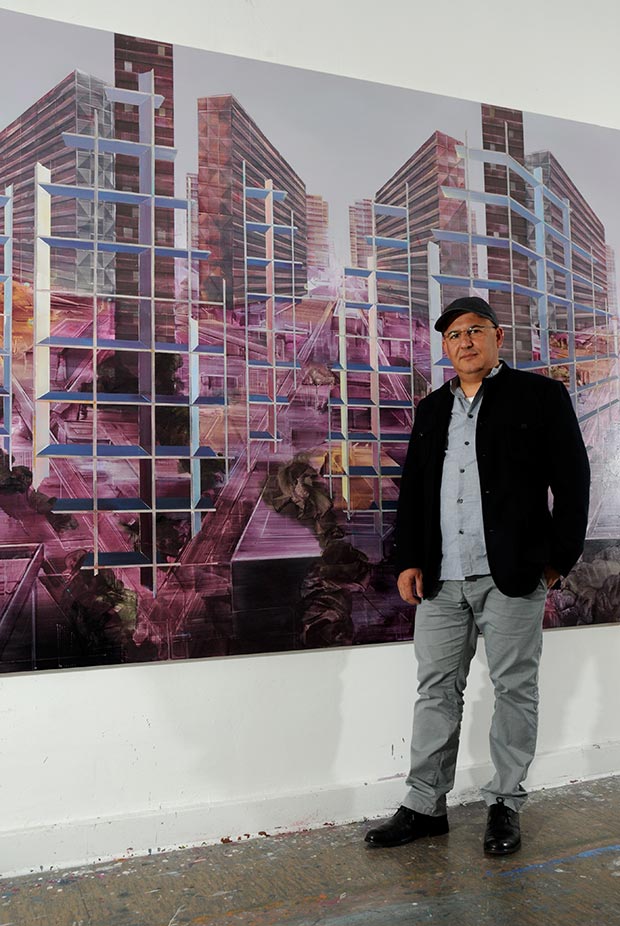 Driss Quadahi next to his art / Courtesy of Lawrie Shabibi and the Artist
Driss Quadahi next to his art / Courtesy of Lawrie Shabibi and the Artist
Fresh from being awarded the Grand Prix Léopold Sédar Senghor Prize at the 11th edition of Dak’Art, the Biennial of Contemporary African Art in Dakar, Senegal earlier this year, ‘Inside Zenith’ brings together a selection of new paintings and some works on paper. Continuing his preoccupation with vacant urban environments at the margins of cities in Africa and Europe, these works share a new dreamlike perspective, they feel less literal, moving towards abstraction, the lines blurring between reality and the artist’s imagination.
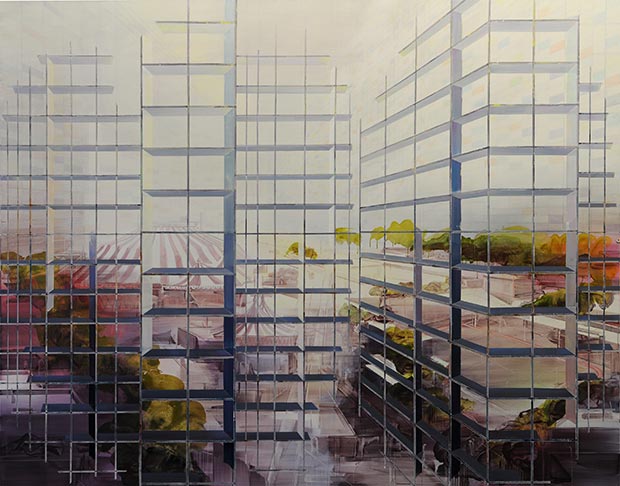 Driss Quadahi, Circus day / Courtesy of Lawrie Shabibi and the Artist
Driss Quadahi, Circus day / Courtesy of Lawrie Shabibi and the Artist
The work that inspired the title of the exhibition is modelled on impressions Ouadahi has built up of Dubai during recent visits. His method of practice involves working from photographs taken during his travels and meshing them with images from his memory to create a collage of different buildings and spaces, constructing a new, fantastical urban structure each time. He is interested in how to transpose the monumental, dream-like architecture of the Gulf States into the space of a painting, giving us a variety of viewpoint at once, replicating the palimpsest often at play. Some buildings, waterways and open spaces in the painting appear familiar and yet are difficult to precisely locate. Inside Zenith is really an impossible place to inhabit - ‘zenith’ refers to an imaginary point in the celestial sphere directly above a particular location, which you cannot get inside. Zenith also suggests success or power and is therefore a rather appropriate word to define Dubai, its exponential growth and seemingly limitless ambition.
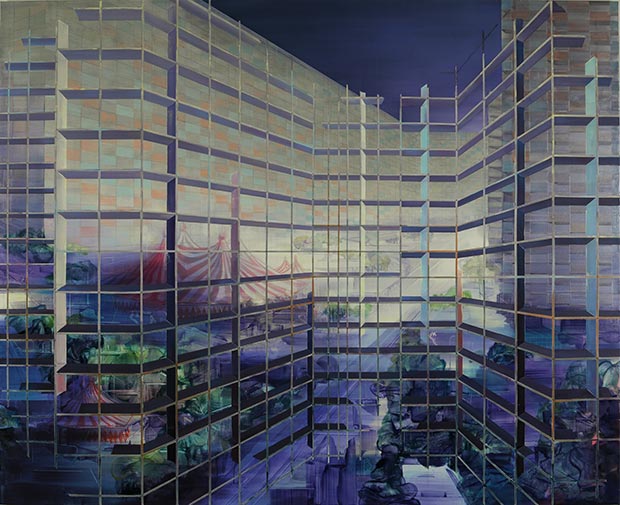 Driss Quadahi, Circus night, 200x250 cm / Courtesy of Lawrie Shabibi and the Artist
Driss Quadahi, Circus night, 200x250 cm / Courtesy of Lawrie Shabibi and the Artist
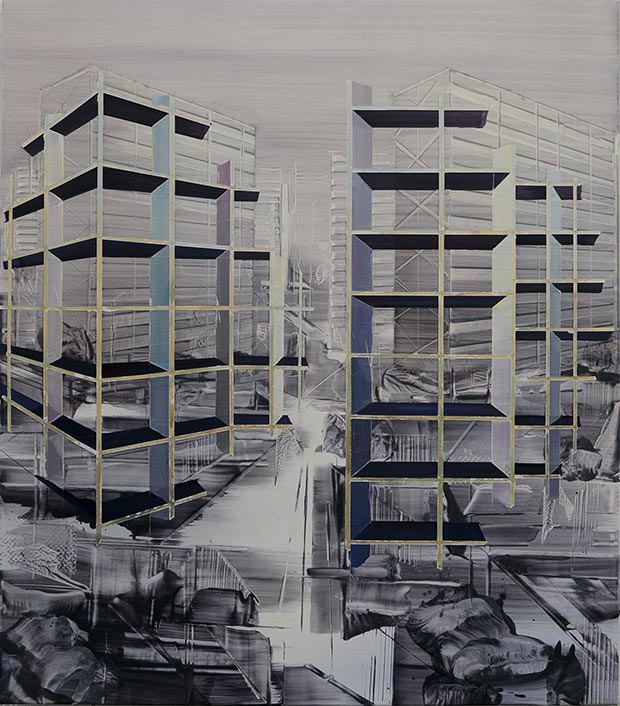 Driss Quadahi, Untitled, 80x70 cm, 2014 / Courtesy of Lawrie Shabibi and the Artist
Driss Quadahi, Untitled, 80x70 cm, 2014 / Courtesy of Lawrie Shabibi and the Artist
Other new works specifically recall personal memories for Ouadahi. Circus Day and Circus Night were sparked by a visit the artist made earlier this year with his elder brother to Casablanca to look for where they lived during their childhood. They found their first home, one of the first housing projects (Unite d’habitation) in Casablanca built in 1953 by the architect Alexandre Courtois, but the family had moved by the time Ouadahi was three years old so he has no recollection of the place. All he can remember from that time is a momentary vision of a circus. In this pair of landscapes the only suggestion of the circus is the familiar red and white striped big top tent, even more extreme and dreamlike in Circus Night.
 Driss Quadahi, face à face, 200x260 cm / Courtesy of Lawrie Shabibi and the Artist
Driss Quadahi, face à face, 200x260 cm / Courtesy of Lawrie Shabibi and the Artist
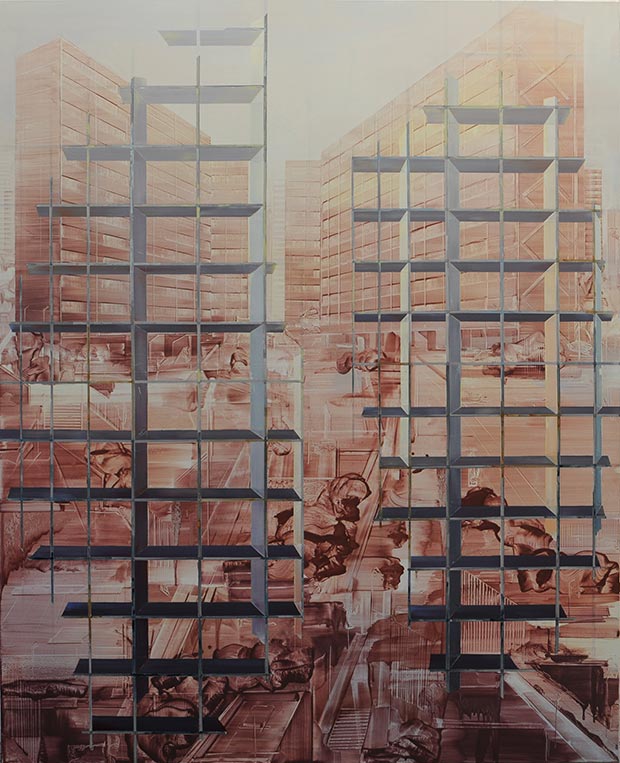 Driss Quadahi, Motionless, 200x170 cm, 2014 / Courtesy of Lawrie Shabibi and the Artist
Driss Quadahi, Motionless, 200x170 cm, 2014 / Courtesy of Lawrie Shabibi and the Artist
Ouadahi has altered his palette and the way he applies oil to canvas. Each work has a dominant tonal colour, sometimes a rusty brown (as in Motionless), sometimes grey or charcoal with warmer hues diffused, creating an impression of natural light falling on the landscape (as in Fusion), and sometimes a greenish-blue, either closer to cyan, cobalt or midnight blue depending on the time of day (as in Graces). The compositions are dominated by the angled, linear structures running throughout the landscapes –the buildings depicted as well as road junctions, stairways and railings and the signature grids he inserts at the front of all scenes. This repeated patterning, possibly scaffolding, balconies or venetian blinds - feels like an impenetrable skeleton of a building, a barrier; breaking down our view of the environment beyond.
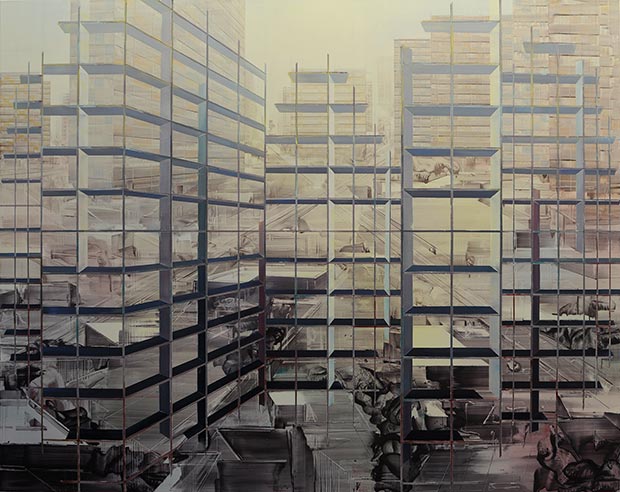 Driss Quadahi, Fusion, 190x240 cm, 2014 / Courtesy of Lawrie Shabibi and the Artist
Driss Quadahi, Fusion, 190x240 cm, 2014 / Courtesy of Lawrie Shabibi and the Artist
 Driss Quadahi, Laisse béton, 180x260 cm, 2014 / Courtesy of Lawrie Shabibi and the Artist
Driss Quadahi, Laisse béton, 180x260 cm, 2014 / Courtesy of Lawrie Shabibi and the Artist
Respite and balance is given by Ouadahi’s depiction of smaller, bulky, rounded, abstract objects seemingly randomly placed on the ground. In Inside Zenith these are depicted in green, representing foliage, the only living presence. In other works the forms are harder to define, perhaps abandoned construction materials, broken columns, crumpled wrapping, general urban detritus decomposing into billowing smoke. They create a more alive, romantised impression of the spaces: in technique these swirling, circular forms feel close to pen and ink sketches by old masters such as Rubens, Goya or Rembrandt. It feels as if Ouadahi has come to terms with the failure of modernist urban planning and despite the brutality of the structures we live surrounded by, the ugliness of cheap high rises and unfinished construction sites, beauty and poetry can still be found and emerges through his painted images.
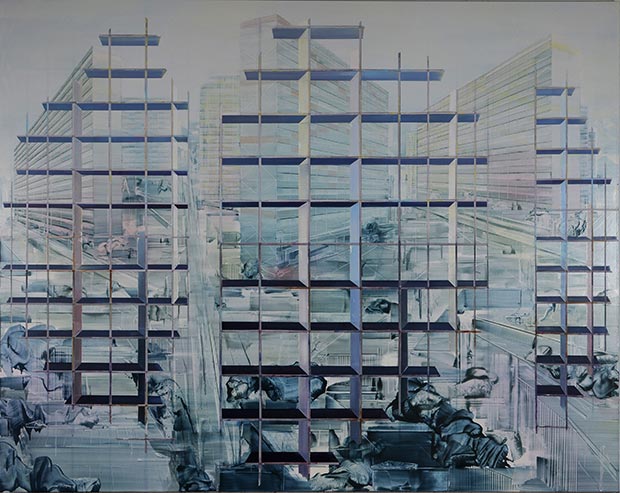 Driss Quadahi, Graces, 190x240 cm, 2014 / Courtesy of Lawrie Shabibi and the Artist
Driss Quadahi, Graces, 190x240 cm, 2014 / Courtesy of Lawrie Shabibi and the Artist
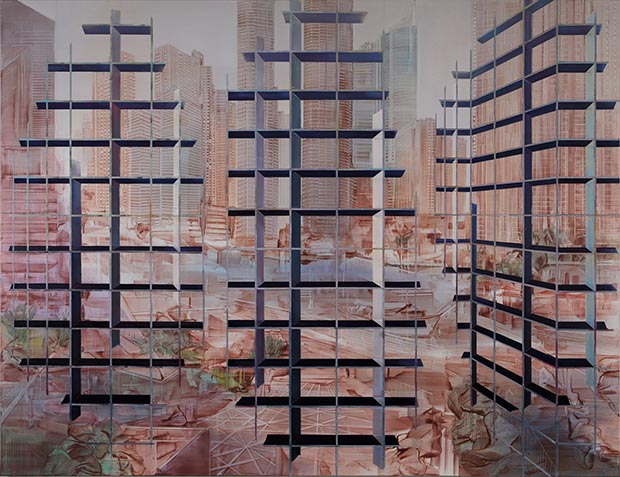 Driss Quadahi, Inside zenith, 200x260 cm / Courtesy of Lawrie Shabibi and the Artist
Driss Quadahi, Inside zenith, 200x260 cm / Courtesy of Lawrie Shabibi and the Artist
Born in Casablanca, Morocco, of Algerian parents in 1959, Driss Ouadahi grew up in Algeria. Originally training as an architect, he studied at the Ecole Superieure des Beaux Arts d'Alger before enrolling and subsequently graduating from the Kunstakadamie Düsseldorf, the city where he now lives and works. Ouadahi has held solo exhibitions in New York, San Francisco, Düsseldorf, Germany, and Istres, France. He has also taken part in a number of group exhibitions such as 25 Ans de Créativité Arabe, Institute de Monde Arab, Paris; Le Retour, 3ème Festival International d'Art Contemporain d'Alger; Magreb: Dos Orillas, CÃrculo de Bellas Artes, Madrid; Future of a Promise at Venice Biennale 54, Cairo Biennial 12, and CU Art Museum, University of Colarado in Boulder. His work is in the public collections of the Herbert-Weisenburger-Stiftung, Rastatt, Kunstmuseum Düsseldorf, Nadour Collection, Barjeel Collection, Kamel Lazaar Foundation and Stadtsparkasse Baden-Baden. Prizes include Centre d'Art Contemporain, Istres, Marseille (2003) and the Grand Prix Léopold Sédar Senghor Prize at the 11th edition of Dak’Art, the Biennial of Contemporary African Art in Dakar, Senegal (2014).
Lawrie Shabibi is a contemporary art gallery housed in a 3000 square foot warehouse in Dubai's Alserkal Avenue. The gallery’s programme has been to support a multi-generation of international contemporary artists mainly from the Middle East, North Africa and South Asia. By holding a regular programme of exhibitions, screenings and talks, publishing catalogues and participating in international art fairs, the gallery engages the wider local and international community. The gallery represents Hamra Abbas, Adel Abidin, Wafaa Bilal, Asad Faulwell, Nadia Kaabi-Linke, Taus Makhacheva, Nabil Nahas, Driss Ouadahi, Nathaniel Rackowe, Marwan Sahmarani, Larissa Sansour, Yasam Sasmazer, Shahpour Pouyan and Adeel uz Zafar.
Comments
Add a comment